Author: Sharon Jang | Reviewer: Emma M. Smith | Published: 4 March 2020 | Updated: ~
Powered wheelchairs and scooters are an important part of independent living after spinal cord injury (SCI). This page provides an overview of the basics of choosing a powered wheeled mobility device after SCI. For more general information on wheelchair provision and wheeled mobility devices, please see our page on the wheelchair provision process. Although this page mentions specific products, SCIRE Community is not affiliated with and does not endorse any of these products.
Key Points
- Power wheelchairs may be used by people who need greater support and assistance for mobility.
- Power wheelchairs are normally classified by their drive (rear-wheel drive, mid-wheel drive, front-wheel drive).
- There are many adjustable parts on a power wheelchair to ensure your safety and comfort.
- Other powered mobility options other than wheelchairs are available (i.e., scooters, Segways); however, they are not often used by individuals with SCI.

A typical power wheelchair includes a metal frame containing a motor and battery, a seat with a backrest, footrests, small caster wheels in the front and/or back, and two large rear wheels at the back. It is propelled and maneuvered using a joystick or other control function.1
Power wheelchairs are mobility devices powered by a battery and motor, and operated by the user or by another person, such as a caregiver. Power wheelchairs may be controlled in a number of different ways: by hand using a joystick, by head movements through head array systems, by the breath through sip-and-puff controllers, and by other specialty controls. This allows power wheelchairs to be used by individuals with high cervical SCI.
Power wheelchairs are typically used by those with limited control of the muscles at the elbow (complete injuries above C5) or other reasons which make it difficult to propel a manual wheelchair. Additional factors that may encourage the use of a power wheelchair over a manual wheelchair include:
- Improved independence (if the individual is unable to effectively propel a manual wheelchair)
- Avoidance of overuse injuries
- Increased speed (if the individual has weak upper body strength)
- Lengthening the amount of time that a person can spend in the wheelchair
- Improves the ability to participate in important activities more easily
Types of power wheelchairs are described by the base. The base is the bottom portion of a power wheelchair that houses the motors, batteries, drive wheels, casters and electronics. The seating system sits on top of this base. The base is classified according to the drive wheel location relative to the system’s center of gravity. The three classifications of power wheelchairs are rear-wheel drive, mid-wheel drive, or front-wheel drive, each with their own benefits and drawbacks.

Rear-Wheel Drive.2
Rear-wheel drive
Rear-wheel drive wheelchairs have drive wheels located behind the user’s center of gravity, with casters in front. Benefits of rear-wheel drive wheelchairs include increased stability when travelling at higher speeds. However, rear-wheel drive wheelchairs are the most likely to tip backwards when going uphill, and have a large turning radius which may make it difficult to maneuver in indoor or tight spaces.
Mid-wheel drive
Mid-wheel drive wheelchairs have drive wheels located right below the user’s center of gravity, with caster wheels both in front and behind the drive wheels (Image 3). Benefits of a mid-wheel drive wheelchairs include:
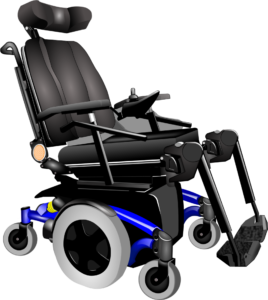
Mid-wheel drive power wheelchair with tilt-in space capability.3
- Having the smallest turning radius, thus making them most effective for indoor mobility
- Being highly sensitive to change in direction
- Being the most stable when going up hills and uneven ground
- Given that mid-wheel drive wheelchairs have a total of 6 wheels as opposed to 4, the user may experience a bumpier ride; however, this can be offset with good quality suspensions. Additionally, mid-wheel drive wheelchairs are not the most efficient at going over uneven ground or soft terrain – users may get stuck when going over these surfaces.
Front-wheel drive

Front-wheel drive power wheelchair with recline capability.4
Front-wheel drive wheelchairs have the drive wheels located in the front of the chair, with caster wheels behind (Figure 4). Some benefits of this type of wheelchair include:
- Being the most stable type of wheelchair when going on uneven terrain and up hills
- Being the best at going over obstacles
- Having the ability to turn around tight corners well
- Allowing the user to pull up close to surfaces as the footplate is closer to the wheelchair since there are no casters in the way
Some drawbacks to front-wheel drive wheelchair include increased difficulty turning in small spaces due to a long back end, less stability when going at high speeds (may tend to fishtail, making it hard to drive in a straight line).
Drive controls
Drive controls for power wheelchairs come in a variety of forms and they are chosen depending on the physical capabilities of the user. Joysticks are used if you have enough arm movement to drive the wheelchair. There are different styles of joysticks available for use, depending on your hand function. This may include ball shaped controls, knob shaped both large and small, stick shaped, as well as U-shaped to name a few. Selecting an appropriate joystick according to your abilities will provide control and precision when driving. For people without the strength or endurance to drive with their arms they may choose to drive with their head, chin or use their mouth with a sip and puff control that is controlled by breath.

Various types of joystick controllers include U-shaped (A), stick (B), and ball (C).5-7
Novel drive systems
With the advancement of technology, more unique drive systems are becoming available to accommodate for a range of abilities. Recently, there has been emerging evidence for:
- Tongue drive systems: This new system allows individuals to drive a power wheelchair with their tongues. For this to work, an individual will need to have their tongue pierced and have a titanium magnetic barbell fitted. Once in place, the user will wear a headset with magnetic sensors. This allows for individuals to move their tongues to certain teeth/spots in their mouth to drive their chair.
- Eye gaze systems: This system uses an eye tracking device, which allows the user to drive a powered wheelchair with their eyes. To maneuver, the user simply looks left to go left, looks right to go right, and blinks for 1 second to start or stop the wheelchair. Weak evidence suggests that users are satisfied with the system and that it may be feasible to accurately drive a wheelchair with the eyes.
- Facial drive systems: New programs allow individuals to drive their wheelchair with various facial movements/emotions as they choose. This includes movements including raised eyebrows, head movement to the left/right, or head movement up/down.
Ultimately, we must note that the tongue drive system is very new, and more research will need to be conducted before its use in practice.
Positioning functions
Power wheelchairs can have the added function of repositioning the SCI user. Repositioning helps shift weight to other parts of the body. This is helpful in providing comfort, supporting posture, and lessening pressure on certain parts of the body.
Tilting
Tilting a power wheelchair maintains the hip and knee angles by shifting both the seat and backrest together. This reduces the chances of rubbing on the skin when moving between positions. Generally, tilting with a power positioning device to a minimum angle of 30° is needed before the beneficial effects of weight shifting can be obtained, while a 55° tilt has been recommended. Additional benefits of tilting include assisting with respiratory function, providing a more comfortable position to rest in without having to transfer to a bed, and increasing stability and balance when travelling on uneven surfaces (e.g., hills).
Reclining
Reclining a power wheelchair consists of the backrest moving backwards/downwards while the seat remains stable. This increases the angle between the seat and the backrest. Some benefits of reclining include stretching out the hips, facilitating toileting and changing catheters, and facilitating transfers for caregivers. There is some weak research evidence that suggests that reclining to 120º may help reduce the pressure applied by the buttock, but reclining back this far also increases the amount of rubbing, which can lead to sores.
Repositioning and pressure sores
One recommended strategy to prevent the development of pressure sores includes weight shifting. Relieving weight off the buttock may help prevent pressure sores by allowing the tissues under pressure to regain blood flow. This is normally done using strategies such as leaning forward or lifting off the seat. If you have a higher level of injury, you may not be able to relieve pressure off your buttock independently. This is where the tilt function of a power wheelchair can come in handy – tilting backwards may help reduce the pressure applied on your bottom and allow for proper blood flow to occur. For more information on pressure relief and sores, check out our page on pressure sores.
 Standing
Standing
Some wheelchairs can support standing in people with SCI. Not only does standing decrease pressure at the sit bones and coccyx, it also provides many other physiological advantages such as maintaining bone mass density, improving circulation, and enhancing functional tasks such as reaching for items on a shelf. It can also be helpful in managing spasticity and for social interaction or certain job functions.
Elevation
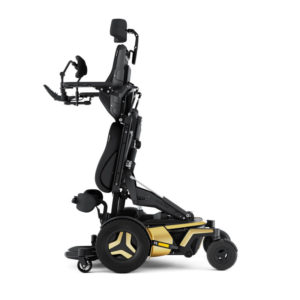
The elevation function of a power wheelchair raises the height of the seat. This is an option that can be added to the chair to enable individuals to reach and access things independently or without shoulder strain. It can also improve social interaction enabling the wheelchair to move to a height where they do not have to look up or be blocked in a room full of people.
Arm rests
Arm rests are multifunctional pieces that are located on the sides of the wheelchair. First, arm rests act as a support for the arm and the shoulder. When in motion, the arm rest help with balance during sudden stops, going up/down hills, and with balance in general. In addition, swelling in the arms may be reduced when the arms are kept elevated. Resting arms on the arm rest may also help maintain upper body posture as the weight of the arms is supported (versus hanging and pulling the upper body downward).
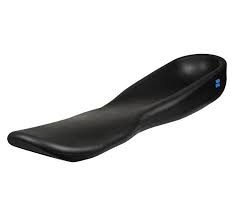
Individuals with cervical level injuries may require a specialized shaped armrest to provide support. 12
Secondly, arm rests can act as a source of stability when weight shifting to relief pressure. Individuals with a SCI can use their arm rest to push themselves up when shifting, or use the arm rest to act as a stabilizer when shifting their weight. For someone who adjusts their position often, gel padded arm rests may be used to increase comfort and support.
Arm rests can be highly adjustable based on various needs.
- Having an arm rest that is too high up may push up the shoulders and may be uncomfortable
- The use of adjustable arm rests may be helpful if the individual wants to be able to pull up to a table
- Some arm rests come with a side panel built in to provide thigh support
- Some arm rests have the function to be flipped up, while other types of arm rests may be completely removed from the wheelchair
- A removable arm rest may be used to help facilitate transfers
Additionally, arm rests for individuals with injuries C4 or above may require special adjustments. Arm troughs (or a more formed arm rest) may be used to provide additional support to the arm to prevent it from moving. In addition, elbow blocks may be used to help support an upright position when tilting. In the case that an individual experiences spams in the arm, sheepskin or gel pads may be used to protect the skin when the arm rests in the trough.
Foot rests: footplates and leg rests
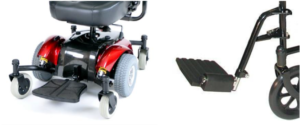
A footplate is generally a single plate (left), while foot rests consist of individual pieces (right). 13,14
Depending on the drive mode, power wheelchairs may have a footplate or leg rests. A foot plate is often connected to the base of the power wheelchair, and is one piece of metal that can be flipped up and down and supports both of the feet. In contrast, leg rests are two separate supports for each foot.
Where the foot rest sits is dependent on the drive base and the physical characteristics of the person. A rear wheel drive wheelchair has footplates the furthest away from the chair as there are caster wheels located on the front. This results in added length to the wheelchair, which may make it harder to turn. The use of a single centre-mounted footplate may help reduce the length of the wheelchair. Front wheel drive wheelchairs do not have front casters that interfere with the foot rests, as the caster wheels are located in the rear. As a result, the foot rests on front wheel drive wheelchairs do not interfere.
Some power wheelchairs may have an option for powered footrests, allowing the user to adjust the angle of the footplates through a motor. To prevent the legs from dangling when using the tilt or recline function, some power wheelchairs may have a foot rest elevation function. This function helps to increase the height and angle of the foot rest to elevate the legs when reclining, and lowers back into the default position when returning to an upright position.
The batteries on a power wheelchair are designed to run for generally 3-9 hours of continuous use, and are made to last for up to 5 years. Some factors that influence how far you can drive on one charge of your battery can be categorized into fixed and varying factors. Many of these factors impact each other, and changing one aspect may influence another.
Fixed factors
Fixed factors influence how long your battery lasts, but cannot be changed. Examples include:
- Weight and size of the battery – a larger battery will allow for a greater driving distance, but adds to the overall weight of the wheelchair
- The drive type of the wheelchair – rear wheel drive wheelchairs tend to use more power than a front or mid wheel drive
- Weight of the wheelchair – a lighter chair will use less battery
- Weight distribution – more weight applied on the caster wheels will use more battery power during manoeuvering
Varying factors
Varying factors are considerations that can influence your battery life in which you can have some control over to a certain extent. These factors include:
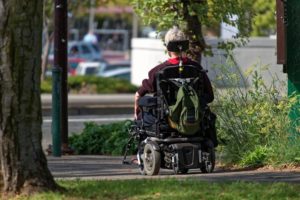
Using a powered wheelchair on smooth even ground in moderate temperatures can help prolong the battery life.15
- The payload of the wheelchair – this is a combination of the user’s weight in addition to any items they may be carrying (e.g., respiratory products, groceries, battery charger, etc.). Most often the maximum payload the battery can handle is much greater than the average weight the power wheelchair carries.
- Properties of the driving surface – driving on uneven, rough, slippery, or soft (e.g., gravel, grass) will use more battery power.
- Temperature – using your power wheelchair in extreme weather (hot or cold) can impact how long the battery lasts for. Using your wheelchair in over 30 degrees or under 0 degrees Celsius will reduce the battery’s normal capacity.
- Driving behaviour – performing a lot of stop and go actions, going up hills, and climbing curbs consume more battery
- Low air pressures in the tires – if you are using pneumatic tires and they are underinflated, this will use up battery faster
- Powered options – using the tilt/reclining functions or powered leg rest functions may reduce the driving range of your wheelchair
If you are using your power wheelchair every day, you should be charging your wheelchair daily. When charging your battery, it is better to charge it for longer amounts of time than in multiple short charges (i.e., less than 2 hours). A minimum charge time of 12 hours or longer has been recommended; power wheelchair batteries will not overcharge! If you are using a new power wheelchair, note that it may take 10-20 charges prior to the batteries reaching their fullest capacity.
While the majority of people who use wheeled mobility devices after SCI will use a manual or power wheelchair, other devices are also sometimes used.
Scooters
Scooters are powered devices that are typically used for getting around in the community. They come in a variety of sizes and in 3 wheeled and 4 wheeled designs. They are often used by individuals whose functional abilities do not require a full-time wheelchair, but may need support when moving around in the community. This support may help a person move greater distances, conserve energy, or get around safely if they have impaired balance, pain, or fatigue. Scooters are typically larger devices compared to wheelchairs, and are controlled by hand controls similar to a bike or motorcycle. They are usually cheaper than power wheelchairs but do not have as small a turning radius and also cannot facilitate complex seating systems. Due to their longer length, they are also more difficult to accommodate in wheelchair taxis or vans.
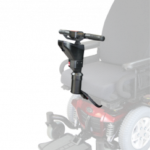
Additionally, there are tiller-like devices that can be added on to powered wheelchairs. This allows powered wheelchair users to operate their device similarly to a scooter. An example of this device is the JoyBar.
Segways
Segways are powered, self-balancing two-wheeled devices with arm bars that a person can stand on to move around in the community. While Segways are not intended specifically to be a rehabilitation device, some people with higher levels of functional abilities (people who are able to stand and balance effectively) may use these devices to assist with getting around in the community in a similar way to scooters. They are considered to be smaller, faster, and more manoeuvrable than power wheelchairs. Early research has suggested that Segways may be a potential mobility option for people with SCI who have limited walking abilities, although there may be some difficulties getting on or off the device.
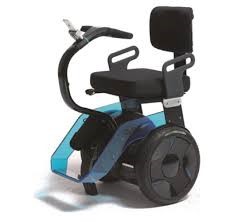
In more recent times, several seated Segway-like devices have started entering the market. These devices (such as the Nino), allow individuals with upper trunk function to drive the wheelchair by leaning forward and to brake the wheelchair by leaning back. More research is required to determine how useful and practical it would be for individuals with spinal cord injury.
As described in this article, many factors play into the selection and set up of a powered mobility device. This article provides you with information on the various parts of a power wheelchair that can be adjusted to suit your needs. If you think that a feature needs to be adjusted or added, consult with your health care or wheelchair provider.
Any reference to a specific product does not constitute or imply an endorsement by SCIRE Community. Professional advice should be sought before making any health care and treatment decisions.
For a review of how we assess evidence at SCIRE Community and advice on making decisions, please see SCIRE Community Evidence.
Titus L, Moir S, Casalino A, McIntyre A, Connolly S, Mortenson B, Guilbalt L, Miles S, Trenholm K, Benton B, Regan M. (2016). Wheeled Mobility and Seating Equipment Following Spinal Cord Injury. In Eng JJ, Teasell RW, Miller WC, Wolfe DL, Townson AF, Hsieh JTC, Connolly SJ, Loh E, McIntyre A, Querée M, editors. Spinal Cord Injury Rehabilitation Evidence. Version 6.0: p 1-178.
Available from: https://scireproject.com/evidence/wheeled-mobility-and-seating-equipment/
Evidence for “What types of power wheelchairs are there?” is based on:
Queensland Spinal Cord Injuries Services. (2019). Comparison of front, mid, and rear wheel drive power chairs. Retrieved from: https://www.health.qld.gov.au/__data/assets/pdf_file/0028/428482/pdwc-comparison.pdf
Evidence for “What parts of a power wheelchair should I know about?” is based on:
Agency for Clinical Innovation. (2020). Ke2p the big picture in mind. Retrieved from: https://www.aci.health.nsw.gov.au/networks/spinal-cord-injury/spinal-seating/module-10/keep-the-big-picture-in-mind
Boninger, M. and the Model Systems Knowledge Translation Center. (2019). The power wheelchair: what the spinal cord injury consumer needs to know. Retrieved from: https://msktc.org/sci/factsheets/wheelchairs/The-Power-Wheelchair
Giesbrecht EM, Ethans KD, & Staley D. Measuring the effect of incremental angles of wheelchair tilt on interface pressure among individuals with SCI. Spinal Cord 2011;49:827- 31.
Kim J, Park H, Bruce J, Sutton E, Rowles D, Pucci D, et al. The tongue enables computer and wheelchair control for people with spinal cord injury. Science translational medicine 2013;5(213):213ra166.
Kim J, Park H, Bruce J, Rowles D, Holbrook J, Nardone B, et al. Qualitative assessment of tongue drive system by people with high-level spinal cord injury. Journal of rehabilitation research and development 2014;51(3):451-466
Kim J, Park H, Bruce J, Rowles D, Holbrook J, Nardone B, et al. Assessment of the tongue- drive system using a computer, a smartphone, and a powered-wheelchair by people with tetraplegia. IEEE Transactions on Neural Systems and Rehabilitation Engineering 2016;24(1):68-78.
Laumann A, Holbrook J, Minocha J, Rowles D, Nardone B, West D, et al. Safety and efficacy of medically performed tongue piercing in people with tetraplegia for use with tongue- operated assistive technology. Topics in spinal cord injury rehabilitation 2015;21(1):61-76.
Queensland Spinal Cord Injuries Service. (2019). Powerdrive Wheelchair Features. Retrieved from: https://www.health.qld.gov.au/__data/assets/pdf_file/0024/425625/pdwc-features.pdf
Stewart, D. (2019). Wheelchair arm rests. Retrieved from: https://mobilitybasics.ca/wheelchairs/armrests
United Spinal Association (2019). Wheelchair armrests – what do they really do? Retrieved from: https://www.unitedspinal.org/wheelchair-armrests/
Evidence for “What impacts battery life” is based on
Invacare. (2020). How to charge and maintain a battery on a power wheelchair. Retrieved from: https://www.passionatepeople.invacare.eu.com/charge-maintain-battery-power-wheelchair/
Karman. (2020). Power wheelchair batteries: understanding how the battery works. Retrieved from: https://www.karmanhealthcare.com/power-wheelchair-batteries-understanding-how-the-battery-works/
Scootaround. (2019). How long do wheelchair batteries last? (and battery life tips!). Retrieved from: https://scootaround.com/en/how-long-do-wheelchair-batteries-last-and-battery-life-tips
Image credits:
- Modified from: Wheel isolated ©MBGX2, Pixabay License
- Mid wheel drive Image ©Br Yonten Phuntsok, Pixabay License
- Wheel isolated ©MBGX2, Pixabay License
- Front wheel drive ©Stephen B Calvert Clariosophic, CC BY-SA 3.0
- U-shaped joystick handle ©Bodypoint
- Large ball ©Permobil
- Joystick ©Wheelchair and Scooter Repair
- Midwheel drive power wheelchair with tilt-in-space capability ©Model systems knowledge translation center (MSKTC)
- Front wheel drive power wheelchair with recline capability ©Model systems knowledge translation center (MSKTC)
- Power elevating seat ©Model systems knowledge translation center (MSKTC)
- 2019 F5 Corpus VS ©Permobil
- Molded wheelchair arm rest ©Comfort Company
- Intrepid mid-wheel power wheelchair ©Intrepid
- Conventional footrest ©David Stewart
- Motorized wheelchair wheelchair elderly man ©Kevin Philips, Pixabay License
- Welland Transportation ©Zdlpwebb, CC BY-SA 4.0
- JoyBar © Joybar
- Segway ©Ivva,CC BY-SA 2.0
- Nino Segway Wheelchair ©Gyronova





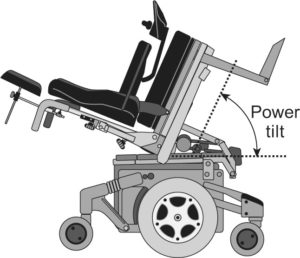
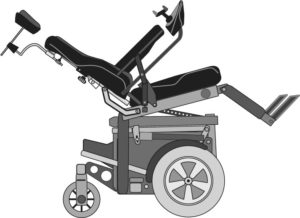
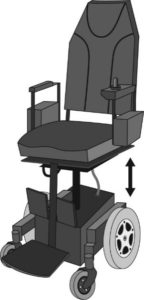 Standing
Standing

